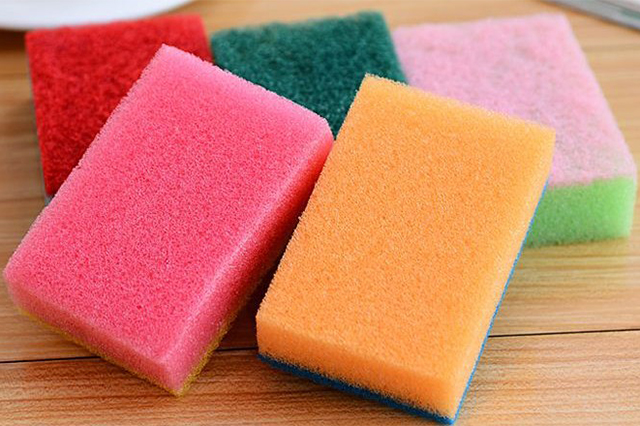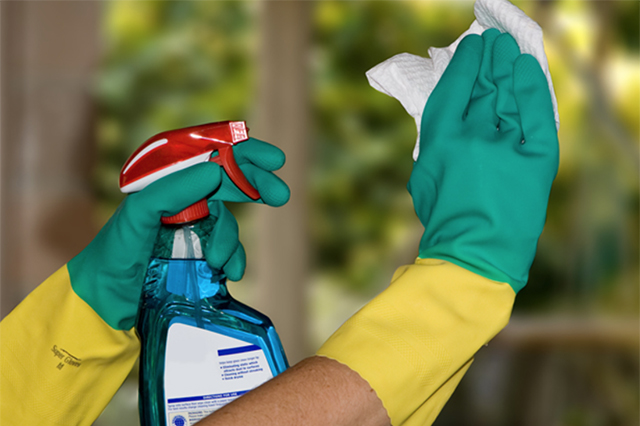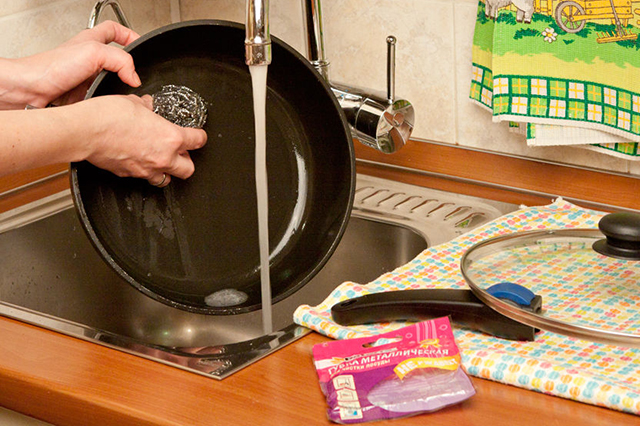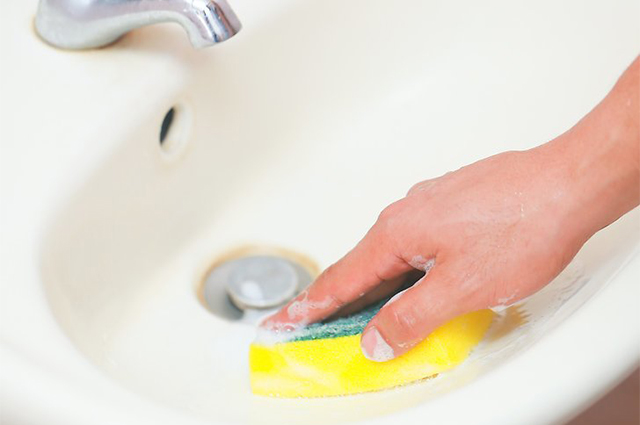Composition of abrasive cleaners
The composition of cleaning agents with abrasives includes detergent components and abrasives, solid particles of quartz sand, sodium bicarbonate, borax, and other fillers. Such cleaners make it easier to clean especially dirty places in the kitchen and bathroom, on dishes and sanitary ware. Abrasive cleaners are available as powders and pastes, sometimes as a suspension. They usually contain surface active agents (surfactants), sodium metasilicate, soda ash, sodium tripolyphosphate and disinfectants with or without chlorine. Flavored with various fragrances. Carefully ground powders of sand, pumice, chalk, and borax are introduced as abrasives.
In pasty abrasive cleaners, the softest abrasive in the form of pumice is usually added. In addition to the substances listed above, water, glycerin or ethylene glycol are added to the pastes. The latter do not allow the paste to dry quickly and soften the skin of the hands after exposure to chemical components.
Use of abrasive cleaners
sinksApply cleaning paste to the contaminated surface. After applying the product and cleaning, rinse well and wipe the surface to be cleaned dry. This will make it shine. Stainless steel sinks are best cleaned without the use of abrasive products and without chlorine, which can corrode the metal. If the contamination is severe, try cleaning a small area, if there is no damage, you can start cleaning the entire surface of the sink. And glass sinks are best cleaned with liquid products without abrasives.
Baths
Acrylic and cast iron bathtubs abrasives permanently not recommended. Only for removal of strong pollution. In enameled baths, the enamel under the action of abrasives can gradually break down, become rough to the touch and lose its luster.
Toilet bowls
It is good to clean toilet bowls with weak abrasive agents, it is better to clean metal and plastic parts of toilet bowls without abrasives with liquid detergents. Faucets are best cleaned without the use of abrasives, mild detergents and rubbed with a dry cloth to restore shine.
Enamelware
For enamelware, you can use abrasive cleaners only to remove stubborn dirt or burnt areas, soot or calcium deposits from water. But you can safely clean the tiled surface with abrasive products. They are easy to remove imperceptible droplets of fat from the surface of the tile near the stove and sink.
In order for the kitchen and the house to be cozy, the hostess must maintain cleanliness. That is why cleaning products are needed that allow you to maintain order. The modern market offers a huge range of products for washing or cleaning the kitchen, bathroom and the whole house. Such products are divided into abrasive and non-abrasive.
Ordinary dirt from city roads is nothing compared to the black dust from the blocks. Moving forward, we decided to do a test, this time taking a rim cleaner for the rim. To maximize center efficiency with dirty wheels, we used the above formulas only on the front wheels in two cars where the pads were replaced a month ago. This means the frames were quite dusty and covered in abrasive pads.
The first drug we used was Tenzi Enji. It is a base fluid that is ready to remove current contaminants from any type of wheel rim, tires and tyres. It removes mineral deposits and dust from brake pads, and current dirt is safe for paintwork. The picture below shows some of the strongest wheels we have ever used.
Abrasives are used to clean stubborn stains. They consist of detergent components and solid particles (quartz sand, soda, borax, etc.). All of them differ in the degree of abrasiveness and are used for different surfaces. The list of such products is large, and therefore they are divided into dry, liquid, disinfectant.
Composition of abrasives
These products are used for quick cleaning of dirt, difficult spots, plaque, solid deposits. They allow you to clean up faster if used in a timely manner. The only disadvantage of such cleaners is that after a while scratches appear on the surface.
After the application, we waited about 1 minute and went to rivet the rim under pressure. What have we put on our eyes? First of all, not all the dirt was washed away. Perhaps this is a matter of an inefficient atomizer, which was used until recently. Currently, formulations have much better injectors. Of course, in a situation of impotence, we can help you with a brush or a regular comb with delicate hair.
Suitable for cleaning heavily soiled discs and other aluminum and stainless steel components. The drug is dangerous, so it can be used to coat glass, so it is recommended to use it in accordance with the manufacturer's recommendations. After applying and waiting for 1 minute, we tear out the rim under pressure. Our task was to make the preparation much better with dirty wheels than its predecessor. Of course, we must note that it is this concentration and the strength of our preparation that we decide for ourselves.
Abrasive cleaners are commercially available in powder, paste or suspension form. They consist of surface-active substances (surfactants), sodium metasilicic acid, baking soda, sodium tripolyphosphate, disinfectants with or without the inclusion of chlorine.
Perfumes are used to give a pleasant aroma. To manifest abrasive properties, carefully crushed sand, pumice, chalk, borax, etc. are used.
The product has become the most used cleaner you buy due to its effective formula that provides excellent washing properties. The product does not leave spots or streaks. It is safe for all types of discs and reels, but the application itself is very effective because the center turns red during operation. As you can see in the image below, the rim is cleaned from the smallest dirt and dust from the brake pads. In this case, there was not even a need for a brush. We highly recommend this product!
Can be used as a pre-treatment cleaner and as a flushing fluid. The center is highly concentrated and uses a bloody rim during the actual application. After application, the rim was pressure washed, and, as we can see, the dirt was cleaned from brake pads and road dirt. The product was able to handle without too much trouble and we liked it.
The degree of abrasiveness of cleaning products is different: the larger the particles, the more abrasive it is, the smaller, the more delicate. Dry and liquid products contain fats that soften the aggressive action of the particles. The group of abrasives includes the following tools: sponges, scrapers, stones, etc.

It seems to me that there is no way to pay, just buy a roton and see for yourself what this center can do. Roton and only the revelation of rodons in clean rims. Very cool article. I'm sorry that there was nothing new to read your articles. The dirtiest discs are definitely Roton and a little less - that's enough other means.
Very cool offers, affordable price of elegance! Well written, well described, there may be more such articles. Furniture cleaning should be carried out regularly. It's not a hassle if we have furniture made of easy-to-clean surfaces and we have a few knick-knacks that stand on top. If we have atypical furniture, cleaning and maintaining them can be a challenge.
The abrasive effect is realized due to various components. Cleaning is facilitated by silica, feldspars and other minerals. In addition, contaminants are removed using fine wire, copper, nylon, melamine.
The composition of the pasty products includes pumice, which guarantees a mild abrasive effect. In addition, they contain the following components: water, glycerol, ethanediol-1,2. Thanks to these ingredients, the paste dries out more slowly, softens the skin on the hands after contact with chemicals.
Shower cabin cleaning
Wash the furniture with a cloth dampened with soap and water, dishwashing liquid or ammonia, without abrasives or bran water, rinse thoroughly and wipe dry immediately. For washing, you can also use a solution consisting of 200 ml of denaturation and a few drops of ammonia. Natural wood rubs with a soft cloth along the grain; wipe several times a year with 24% hydrogen peroxide so that it does not darken. Engrave the ash with water moistened and well clamped, and then wipe dry immediately. To clean peanuts, use kerosene, leave until it is absorbed, then polish. Use linseed oil, to decorate ebony and teak, leave until it is absorbed, then polish with a soft cloth. Stubborn stains can be smeared with a brush. Wash with soap and water, rub it with the lemon half, then rinse and pat dry. To lubricate the surface, wipe it with a solution of water with two to three tablespoons of ammonia and a few drops of glass cleaner and wipe thoroughly with a dry cloth. Scrub the iron with a brush, then wipe with a cloth soaked in kerosene to prevent rust. Painted iron can be cleaned with water and a non-abrasive cleaner, but be sure to rinse and wash them thoroughly. For antiques to look beautiful, never neglect the ordinary vacuum cleaner, hard-to-reach places, such as all kinds of grooves, brush clean. Do not use conventional wood care products, in chemical stores you will find a selection for protection old furniture. In case of significant dirt, wipe the furniture thoroughly cleaned with water soaked in a solution of three tablespoons of vinegar per liter of water. Vacuum seats should be vacuumed with a brush and then wiped with a solution of water and coarse salt. Be careful not to get wet. The durability of cane lace will lengthen with lemon halves. To properly clean a chair, rub it with water and plenty of salt, then expose it to the sun or dry it with a dryer so that the fibers shrink again. Use a hydrogen peroxide bleach solution. Wood waxed dust and wax, and when dry carefully polished. . Dirty shower or bath screens are limescale deposits, soapy water, and dry water droplets, meaning "daily bath".
When using a detergent with abrasive particles, the likelihood of scratches increases. Porcelain and enamel surfaces become dull, and polishing is damaged if abrasives are abused on stainless steel.
Aggressive cleaners are not recommended for cleaning glass, marble or laminate. In such cases, it is better to give preference to soft remedies. If the stains do not disappear, then you can try delicate abrasives. In any case, before using cleaning products, carefully read the instructions for use.
It is especially important that with constant contact with water screens and showers, special attention is needed. In order to completely clean the shower enclosure and not damage it, we must receive special training. Shower cleaners are available on the market. Leave the liquid on for 15 minutes, then use a sponge or cloth to wipe off and rinse thoroughly with water.
Most of the kitchens used in our kitchens are made from laminated boards and are easy to clean and maintain. Liquids for dishwashers or liquid detergents for lacquered surfaces and oil paints can be successfully used to remove dust and grease from such furniture. If there are grease stains on the furniture, we use a concentrated liquid without diluting with water. Do not use abrasive preparations such as powders, cleaning pastes or cleaning milks to clean furniture.

Application of dry and liquid abrasives
Powdered abrasive products are popular. They are often used before polishing. various surfaces. Products are created on the basis of small mineral particles of calcareous spar, feldspars, silica, etc.
When used, minor scratches are created on the laminated surface of the furniture. After removing the dirt from the furniture, you need to wipe it several times with a flannel cloth and wipe it thoroughly to dry. If you want to make your furniture shine and protect your surface from dust, you need to use the right preservative. Modern preservatives contain polishing agents and antistatic agents to prevent the ingress of dust and dust. After their use, a thin layer is created on the surface of the furniture, which also makes it easier to clean the dirt.
Dishwashing powders also include surfactants to remove grease stains. Powders are also used when washing dishes from food, drink or mold residues. These products contain bleaching agents to remove stubborn stains on dishes.
Rust is removed with abrasive powders. These cleaning products contain ethanedioic acid or sodium bisulfite. The abrasive particles included in liquid products are softer than in powders.
In stores, we can find many preservatives, mainly in the form of aerosols or domestic pastes and liquid emulsions. Aerosols are more expensive, but more convenient to use, reverse paste. Best results are obtained by using cleaners to first remove dirt from laminated furniture, and only then preservatives rinse them.
Kitchen furniture made of wood, covered with various paints or oil paints, must be cleaned - maintained in the same way as furniture made of laminated boards. Such furniture is particularly susceptible to staining with grease, juice or coffee, which can penetrate deep into the structure of the wood.
For this reason, they provide a delicate abrasive effect. They are not suitable for heavy dirt and old stains.
cleaning tools
The group of abrasive products includes cleaning tools that have long been used in home use. The most popular product in this category is sponges. Most often, housewives use sponges coated with thin metal wire, which implements the abrasive effect.
The stain can only be removed completely when we know its composition and when it does not penetrate too deeply into the substrate. Next Tips will help you remove the most common places. For colored inks, ink-dyed magnesia, water, and potassium acid oxalate can also be used. Wipe stains after fruit juices and fruit stains with a cloth dampened with sodium hypochlorite solution. You can also leave the solution on the painted surface for some time, and then, after removing it, wipe the painted area several times with a damp cloth. Grease and oil stains are blotchy areas rubbed with gasoline or grease remover. On old stains, we apply a thick layer of magnesia paste and gasoline. Once dry, remove the stained paste. Spot stains - the painted surface of the furniture is carefully wiped with a cloth dampened cold water. When the surface is completely dry, apply a thin layer of furniture preservative to it.
- Spots on ink stains wipe with a cloth lightly dampened with lemon.
- Remember that ink sinks easily into wood.
- Spots need to be drawn immediately.

They clean steel surfaces before polishing. To remove dirt, a sponge is used, as well as a soap-based detergent. However, this cleaning method is used only when absolutely necessary, otherwise the surface quickly deteriorates.
In this way, you will prevent the accumulation of unpleasant odors. Wipe up any spills immediately. Unplug the refrigerator from the power source from time to time. Draw out all moving parts such as shelves, containers, etc. wash them by hand, rinse and dry. Do the same with the inside of the refrigerator. Use a clean sponge or soft cloth and a mild detergent diluted in warm water. Do not use abrasive, strong cleaners such as window sprays, scouring powders, flammable liquids, scouring waxes, strong detergents, bleaches, or petroleum products, especially when cleaning interior plastic components, door linings, or gaskets.
For the manufacture of cleaning sponges, wear-resistant materials are used: copper mesh, stainless steel or nylon wire. Such tools are used without detergents, they are designed to mechanical removal pollution.
Abrasive sponges with color coding carry out cleaning of different surfaces. As they are also called, scrapers are used during construction work. The composition of the tools includes synthetic fibers, abrasive materials, resin. They are used for simple or complex cleaning.
Do not use paper towels, abrasive cleaners or other rough surfaces to clean the product. or with a soft cloth and a mild detergent diluted in warm water. Do not use abrasive, strong water. Use a special wax to coat metal surfaces with a clean, soft cloth. Non-wax plastic parts.
To keep your home in good condition, you don't need a whole shelf of cleaning products from the biggest market, just a few hits and reliable cleaning products. Surely you have them, you just need to learn how to use them. Spiritual vinegar is the most versatile, slightly acidic, and is used to remove grease, bleach and disinfectant, remove stains and odors, and remove mold. Mixed lemon juice and salt or baking soda - they make an even stronger cleanser, remove stains and grease. Salt - has abrasive properties and can be used alone or mixed with lemon juice - an all-purpose cleaner, has antiseptic and disinfectant properties. Purified soda - has abrasive and cleaning properties, removes stains and unpleasant odors. Vinegar mixed with alcohol is an excellent cleaner for bathroom ceramics. Natural soap - Soap dispensers are used for hand wash delicate clothing and soapy water for cleaning. Caustic soda. Removes soap and grease deposits in drainage holes washbasins, washbasins, bathtubs and showers and cleans sewer pipes. Glycerin - helps with various stains. Lemons - Lemon juice is the perfect bleach. . And finally, the art of washing the floor.
blue lips and white color used for delicate cleaning of glass, ceramics, chrome-plated metal. Green and black products are used to remove stubborn stains (cleaning carbon deposits in a pan, old fat in the oven, etc.).
Recently, they have become popular, this material is used for sound or thermal insulation. The product qualitatively cleans surfaces without the use of detergents. Their only downside is that they wear out quickly.
![]()
During the manufacture of such a sponge, melamine resin penetrates into the pores, as a result of which it becomes very hard. It is compared to fine sandpaper, which removes stains with ease. Due to the hollow microstructure, the product absorbs the dirt that remains between the melamine threads.
Cleaning agents for disinfection
The abrasive agent is used not only to eliminate contaminants, but also to destroy pathogens on the surface. In addition to detergents and abrasive particles, their composition includes antimicrobial chemical components.
In addition, such products contain pine oil, quaternary ammonium salts, sodium salt of hypochlorous acid (household bleach).
Disinfectants are used to wash floors, they are used to clean the kitchen or bathroom. Before using them, it is recommended to read the instructions on the abrasive products.
Scope of abrasive products
For cleaning ceramic sinks, an abrasive powder or paste with a delicate action is used. Means treat the surface, clean, rinse thoroughly and wipe dry. After that, the sink will become clean, shiny.

Stainless steel surfaces are cleaned with non-abrasive cleaners that do not contain corrosive chlorine. If the stain is not removed, then an abrasive cleaner is used on the contaminated area. If after its use there is no visible damage, then it is allowed to clean the entire surface.
Glass sinks are cleaned with detergents without abrasive particles. Cast iron and cleaned with abrasive products only in extreme cases. Enamelled surfaces under the influence of abrasives are also destroyed, becoming dull and rough.
Delicate abrasive cleaners are used to clean toilet bowls, and its parts made of metal or plastic are washed with liquid, non-abrasive products. Mixers are cleaned in the same way, which, after removing dirt, are polished with a clean cloth.
Enameled dishes are cleaned with abrasive products only in the presence of persistent dirt, burning, soot, and scale. Products with abrasive particles are suitable for cleaning bathroom and kitchen tiles.
Thus, abrasive detergents are effective products for cleaning surfaces from stubborn dirt. The main thing is to choose the right cleaners for different types surfaces and read the instructions before use. So you achieve crystal cleanliness throughout the house and do not damage the surface.











How to cook ham in the oven at home
Pain in the lower abdomen during pregnancy, reasons for what to do Can the lower abdomen hurt if pregnant
Protein for muscle gain
The best vitamins for men according to customer reviews
How to lose weight on a vegan diet?